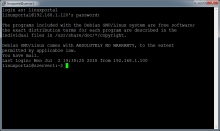A Command Line Interface (CLI) or Command Language Interpreter (CLI) is an interface that allows users (clients) to issue commands to a computer in the form of typed text. The commands entered are handled by the command language processor, which may vary from operating system to operating system. Such command line interface it is on almost all operating systems, Linux for example shellIt's called. The output of processed or executed commands is displayed on the screen, but can also be redirected to files or even to various peripherals.
The command line interface is an effective way to manage computers because it can perform many tasks that cannot be solved in the graphical interface. In addition, most command-line interfaces support the execution of various script programs, making work automated and repetitive tasks easy. Therefore, advanced users, administrators prefer to use different menu-driven graphical interfaces.
In the mid-1960s, the CLI was the primary means of interacting with computers, and continued to be used in the 1970s and 1980s on OpenVMS, UNIX / Linux, and personal computers running MS-DOS, CP / M or Apple DOS system was running.
Today’s modern Unix-like operating systems all have some sort of shell program that can be used in the command line interface and are arbitrarily interchangeable. The most common of these is Bash (Bourne Again Shell), but also known as dash, zsh, ksh shells.
Command shell programs usually have their own set of instructions, control structures (eg loops, branches, etc.) and are able to run external programs and commands that are installed in the operating system. The combination of these is different script programs can be written to effectively control the operating system or other programs. Furthermore, in addition to running scripts, shells can run other server-side programming languages using an interpreter for that programming language. Examples of such languages are PHP, Python, Perl, Ruby, and so on.
On Unix-like operating systems, the command line interface can be accessed remotely (mostly with a username and password), allowing computers running such operating systems to be monitored and managed from anywhere. In the past, this could be done using a network protocol / software called Telnet, but this protocol did not provide encryption, so the line could be intercepted between the two computers. For this reason, it already meets today's security requirements SSH protocol is used for this purpose, which uses strong encryption.
Related Content:
- 764 views

